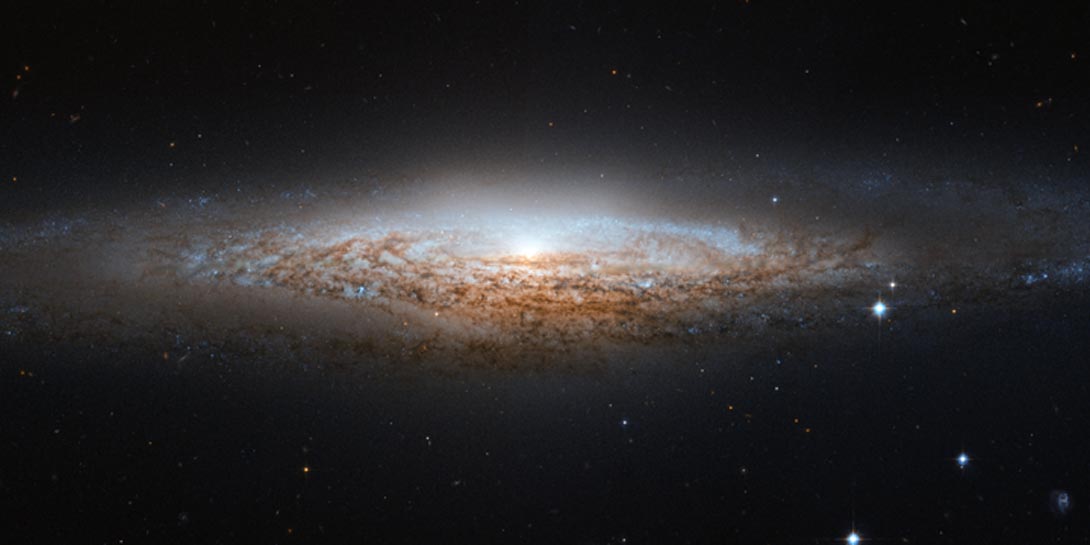
Spiral galaxy
RA 8h 52m 41.16s Dec 33° 25' 28.58"
Lynx
35 million light years
10.6
9.3 × 2.2 arcmin
6.31 x 3.27 arcminutes
North is 131.5° right of vertical
ESA/Hubble & NASA
March 26, 2012
ABOUT THIS IMAGE:
The NASA/ESA Hubble Space Telescope has spotted a UFO - well, the UFO Galaxy, to be precise. NGC 2683 is a spiral galaxy seen almost edge-on, giving it the shape of a classic science fiction spaceship. This is why the astronomers at the Astronaut Memorial Planetarium and Observatory gave it this attention-grabbing nickname.
While a bird's eye view lets us see the detailed structure of a galaxy (such as this Hubble image of a barred spiral), a side-on view has its own perks. In particular, it gives astronomers a great opportunity to see the delicate dusty lanes of the spiral arms silhouetted against the golden haze of the galaxy's core. In addition, brilliant clusters of young blue stars shine scattered throughout the disc, mapping the galaxy's star-forming regions.
Perhaps surprisingly, side-on views of galaxies like this one do not prevent astronomers from deducing their structures. Studies of the properties of the light coming from NGC 2683 suggest that this is a barred spiral galaxy, even though the angle we see it at does not let us see this directly.
NGC 2683, discovered on February 5, 1788 by the famous astronomer William Herschel, lies in the Northern constellation of Lynx. A constellation named not because of its resemblance to the feline animal, but because it is fairly faint, requiring the "sensitive eyes of a cat" to discern it. And when you manage to get a look at it, you'll find treasures like this, making it well worth the effort.
This image is produced from two adjacent fields observed in visible and infrared light by Hubble's Advanced Camera for Surveys. A narrow strip which appears slightly blurred and crosses most the image horizontally is a result of a gap between Hubble's detectors. This strip has been patched using images from observations of the galaxy made by ground-based telescopes, which show significantly less detail.
The field of view is approximately 6.5 by 3.3 arcminutes.
From Wikipedia:
NGC 2683 is a spiral galaxy discovered by William Herschel on February 5, 1788. It was nicknamed the "UFO Galaxy" by the Astronaut Memorial Planetarium and Observatory. It is viewed nearly edge-on from Earth's location in space and is located between 16 and 25 million light-years away. The light from the center of the galaxy appears yellowish due to the intervening gas and dust located within the outer arms of NGC 2683. Its apparent magnitude is 10.6 making it nearly invisible to the human eye without the aid of a small telescope.
While usually considered an unbarred spiral galaxy, recent research suggests it may in fact be a barred spiral galaxy; its bar is hard to see due to its high inclination. Further support for the presence of a bar stems from the X-shaped structure seen near its center, which is thought to be associated with a buckling instability of a stellar bar. It is also both smaller and less luminous than the Milky Way with very little neutral hydrogen or molecular hydrogen and a low luminosity in the infrared, which suggests a currently low rate of star formation.
NGC
2683 is rich in globular clusters, hosting about 300 of them, twice the
number found in the Milky Way. Due to its vast distance and complexity
(due to the association of Globular Clusters bound to it), NGC 2638's
mass has not been calculated as accurately as it could be. Otherwise its
volume and vector motions are reasonably well known and characterized.